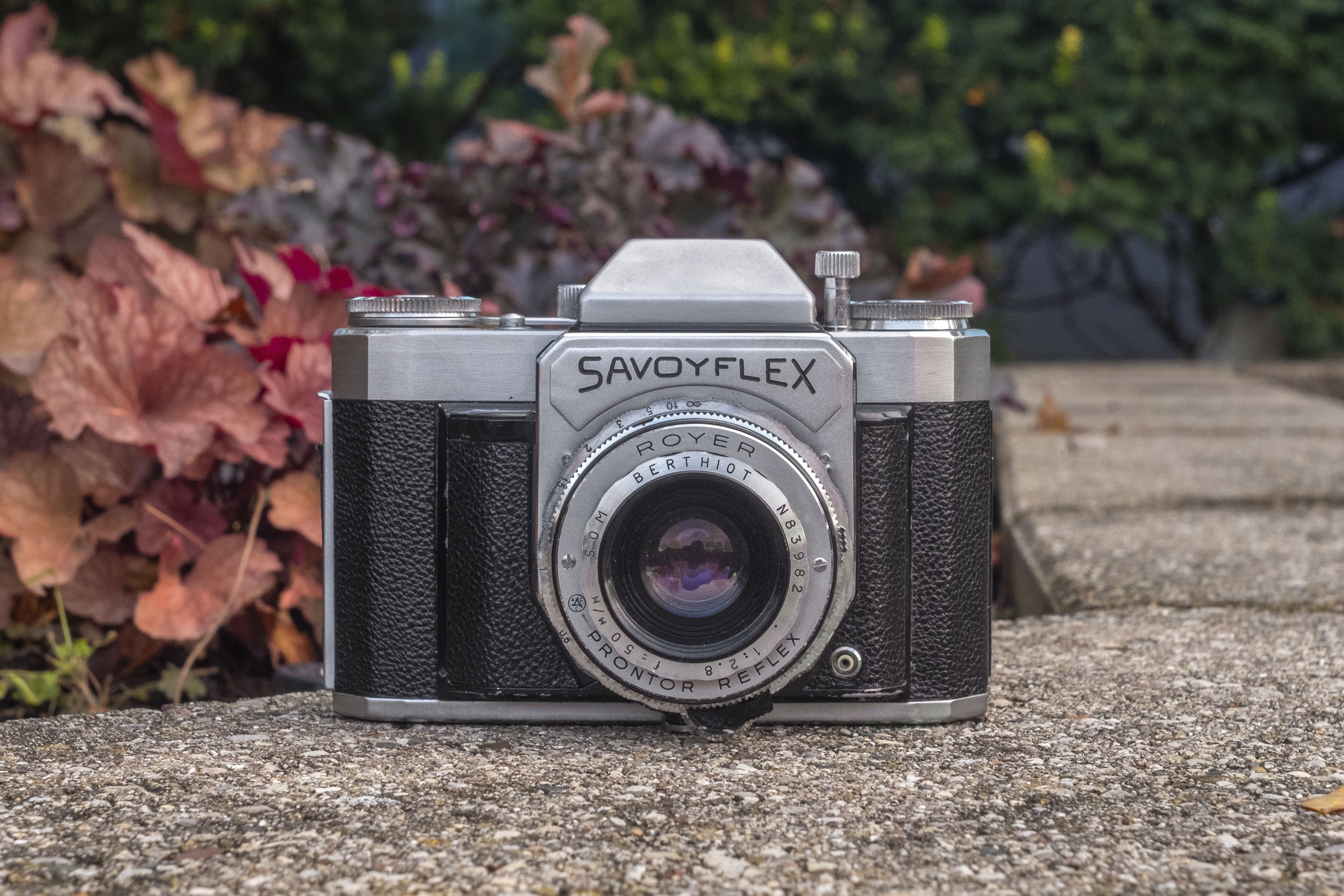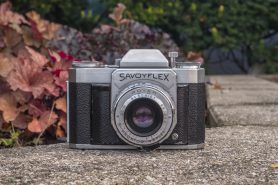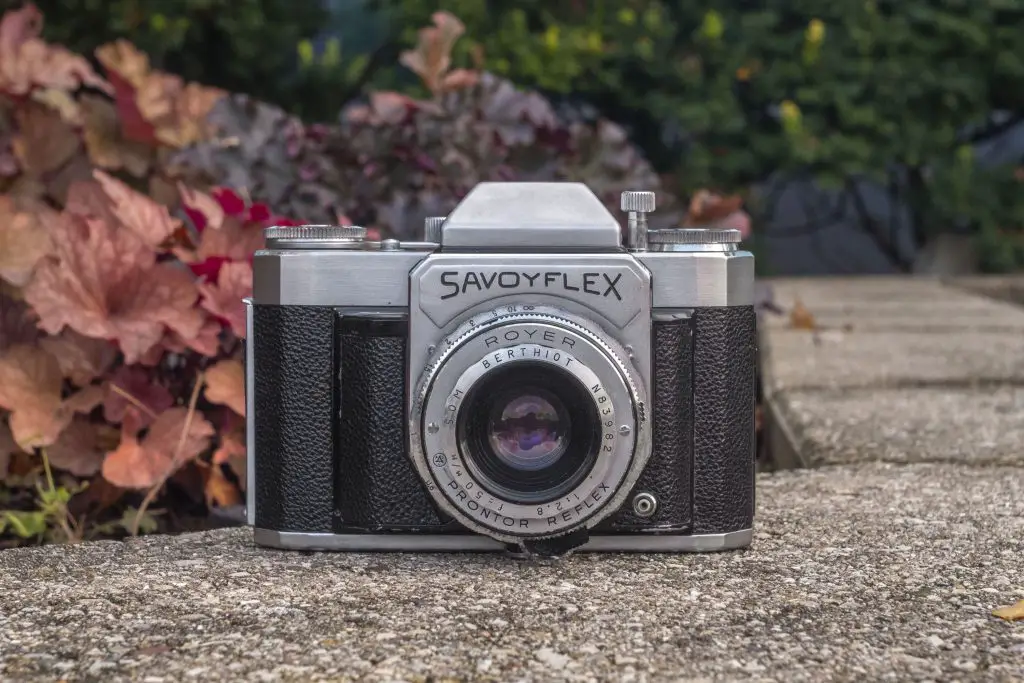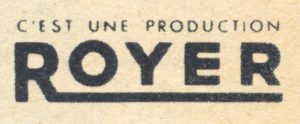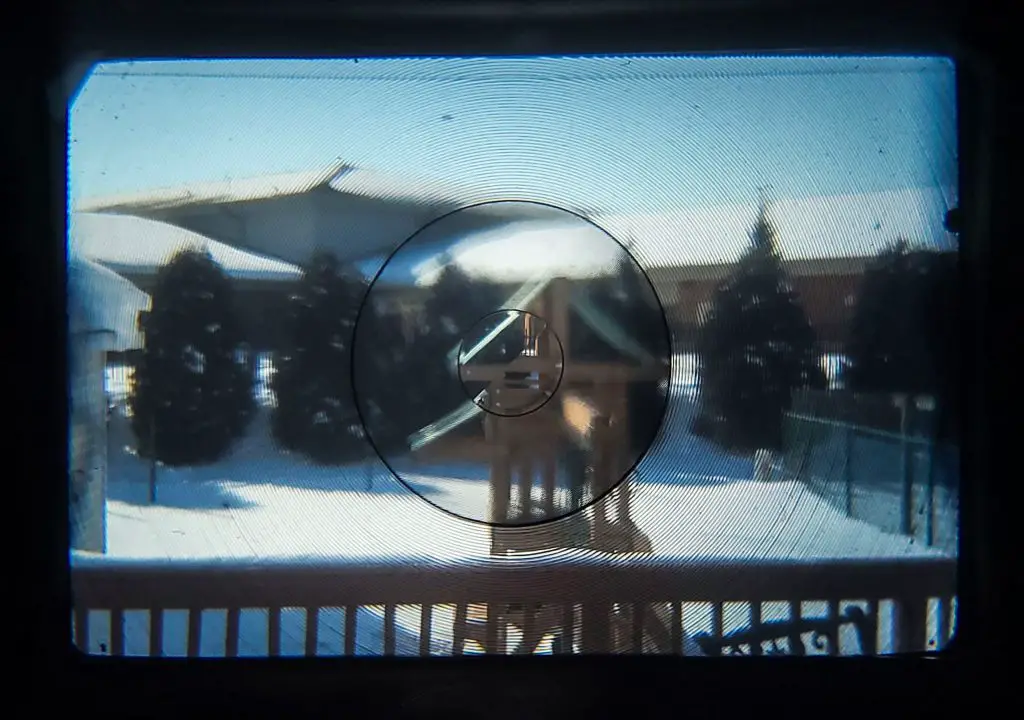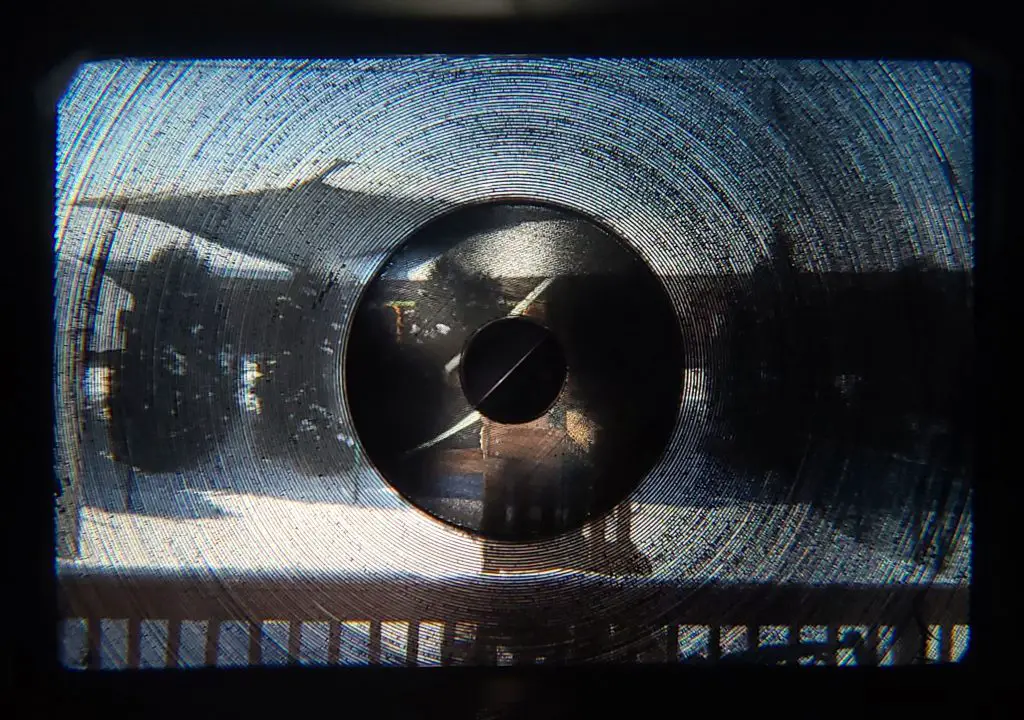This is a Royer Savoyflex II, a 35mm SLR made in France by Société Industrielle de Technique Optique, or SITO for short. The Savoyflex had a between the lens Prontor Reflex leaf shutter, a fixed Berthiot 50mm f/2.8 lens, non-removable pentaprism viewfinder, film advance lever, and an rapid return reflex mirror that was coupled to the left handed shutter release. This was the first in a series of several Savoyflexes, the most advanced called the Savoyflex Automatic was the first SLR with automatic exposure, via it’s coupled selenium light meter. The Savoyflex series failed to compete with the increasing number of less expensive, and better built Japanese SLRs coming on the market at the time, and were discontinued in 1964.
Film Type: 135 (35mm)
Lens: 50mm f/2.8 SOM Berthiot coated 4-elements in 3-groups
Focus: 0.8 meters to Infinity
Viewfinder: Fixed SLR Pentaprism
Shutter: Prontor Reflex Leaf
Speeds: B, 1 – 1/300 seconds
Exposure Meter: None
Battery: None
Flash Mount: PC Port with M and X Flash Sync
Weight: 739 grams
Manual (similar model): https://mikeeckman.com/wp-content/uploads/2021/01/Savoyflex2E3EManual.pdf (in French)
How these ratings work |
The Savoyflex II is a good looking and interesting SLR made in France by a company you don’t often encounter in the United States. Although the camera is reasonably well made and has a good lens, there are several unfortunate design and ergonomic characteristics of the camera that makes it pretty miserable to use. Although I am happy to have this camera in my collection, it is not one I will come back to shoot often as I really did not like using it. | ||||||
| Images | Handling | Features | Viewfinder | Feel & Beauty | History | Age | |
| 1 | 0 | 1 | 1 | 2 | 1 | 30% | |
| Bonus | none | ||||||
| Final Score | 7.8 | ||||||
History
Royer was a brand of cameras produced in France by Société Industrielle de Technique Optique, or SITO for short from about 1948 until the mid 1960s. The company was founded by an optical mechanic named René Royer who had previously worked for Lumière during the war.
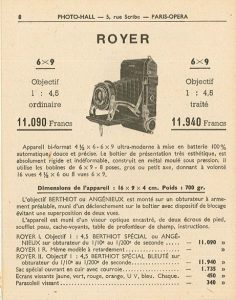
After World War II, the French government instituted some protectionist measures to help speed up the recovery of French industry by forbidding foreign imports in numerous sectors of the economy, including photographic equipment. As a result a number of small photographic and optical companies were created to fill a void in imported photographic goods that could no longer be obtained from Germany and other countries.
Sensing an opportunity to branch out on his own, Royer left Lumière to form his own company and start making cameras under his own name. Royer had experience with folding medium format cameras from his time at Lumière so those were some of the first models produced starting in 1948.
The first cameras, simply called the Royer I and II were inexpensive 6×9 folders that came with either Berthiot or Angénieux lenses in a simple leaf shutter.
In the years that would follow, a large number of variations of that original Royer camera would be created, with incremental changes including better lenses and shutters, some with flash synchronization and others with self timers. The basic body of Royer 6×9 folding cameras would be retained for a while, even on the company’s higher end models.
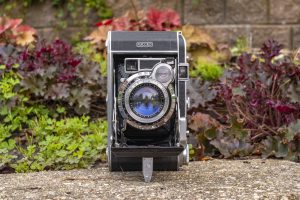
In 1950, a top of the line model called the Royer Teleroy was created with the company’s first ever rangefinder. The prefix “tele-” in the camera’s name is short for telemeter, which is another word for rangefinder, hence the ‘tele-Roy’ or rangefinder Royer.
A unique “feature” of the Teleroy was that it’s rangefinder was entirely self contained on the shutter plate and had no physical connection to the main body of the camera. This meant that the Teleroy rangefinder could be purchased separately as an upgrade to non-rangefinder equipped models. It is not uncommon for companies like Leitz to offer an upgrade service on previous models to add new features, but this is the only instance I am aware of where an entire rangefinder was offered as a factory upgrade on earlier models.
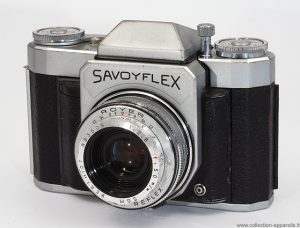
It is not clear when this happened, but by the mid 1950s, the name SITO would no longer appear on the company’s advertisements, instead all cameras being referred to as being made by Royer. Whether or not SITO officially changed it’s name to Royer to identify with it’s most popular product, or if this was just a rebranding is not clear. As Royer, the company would continue to produce other cameras, including a large number of 35mm cameras starting with the simple Savoy scale focus camera, and peaking with the auto exposure Savoyflex Automatic SLR.
In 1958, Royer would release it’s first Single Lens Reflex camera, which they called the Savoyflex II. Over the next couple of years, a variety of Savoyflex models would be released, all using the same leaf shutter, fixed 50mm f/2.8 SOM Berthiot lens, and a non-removable viewfinder, but with the following differences:
- Savoyflex I (1959) – The most basic model is easily identified as having front element focus rather than a focusing helix, no accessory shoe, and a rapid (not instant) return mirror.
- Savoyflex II (1958) – This was the first model released and has a focusing helix, but is otherwise the same as the Savoyflex I. Some later variants of this model have a shutter with a top 1/500 shutter speed.
- Savoyflex III Automatic (1960) – Same as the Savoyflex II, but adds a coupled selenium exposure meter with automatic exposure, and upgrades the shutter with a top speed of 1/500.
- Savoyflex 2E (1962) – Same as the Savoyflex II, but adds an accessory shoe to the top of the prism, and upgrades the rapid return mirror to an instant return mirror. A slider switch on the back of the camera is necessary to manually set the mirror with the shutter set to Bulb.
- Savoyflex 3E (1962) – Same as the Savoyflex III Automatic but adds the accessory shoe and instant return mirror, just like the Savoyflex 2E.
With the exception of the word “Automatic”, none of these sub-model designations appear anywhere on each of the cameras. I have seen period advertisements for the I, II, and III which also have them referred to as the 1, 2, and 3, so both ways of writing them should be considered correct.
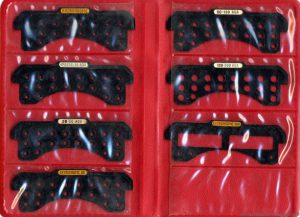
The most advanced model, the Savoyflex Automatic was significant as it was the first SLR in the world to offer shutter priority automatic exposure, via it’s coupled selenium meter in front of the prism. While automatic exposure existed prior to the Savoyflex, it was only available on simpler scale focus and rangefinder cameras. An interesting feature of the Savoyflex Automatic is that there was no setting on the camera to set what speed film you had loaded. In order to achieve proper exposure using a variety of different film speeds, a plastic envelope came with the camera containing seven grilles which must be attached in front of the selenium meter to restrict the amount of light, to compensate for different film speeds. The most restrictive was for ASA 10 films like Kodachrome, and the least restrictive was for ASA 160 films. Without any grilles, the meter was calibrated for ASA 200 speed films.
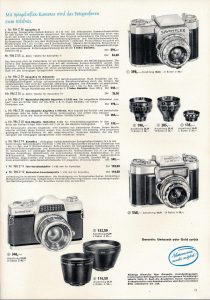
The Savoyflex was sold outside of France, but I found no evidence that it was exported to the United States. In a 1962 catalog from Neckermann in Frankfurt, Germany, the Savoyflex II and Automatic sold for DM 398 and DM 548 respectively.
On the same page as the two Savoyflexes was a Kowaflex SLR selling for DM 348, and in a July 1962 ad from Modern Photography, the Kowaflex had a price of $100, suggesting that had the Savoyflex been sold here, it would have been priced somewhere around that.
None of the Savoyflex cameras had an interchangeable lens mount, so the SOM Berthiot 50mm lens was the only one offered. If you wanted a wide angle or telephoto option, accessory lenses were available that screwed onto the filter threads of the 50mm lens to alter the focal length.
A 35mm wide angle Hyper-Flor and an 80mm telephoto Ampli-Flor were offered, along with a macro lens attachment for closeups. I know for sure these lenses fit the Savoyflex I, but cannot confirm if they fit all models, but my best guess is that they do.
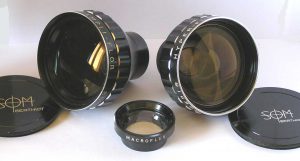
The last Savoyflex SLRs were produced in 1963 at which point the company was only making a couple of their lower end 35mm cameras. By 1965, all Royer camera production had ceased. I was unable to find much info about what happened to SITO or the Royer brand after this time, but from what little I could find, the French optics industry continued to produce items for scientific and perhaps even government resources, but there were no other consumer cameras being made.
My best guess as to what happened was that similar to a large number of other optics companies in the second half of the 20th century, competition from Japan and an expectation for smaller, more advanced models meant that low production companies like SITO could not remain competitive.
Today, there isn’t much of a market for French SLRs, but I suspect that is more of a symptom of a lack of availability. I have no idea how common these cameras are in France or in other parts of Europe, but they are nearly impossible to find in the United States. You have to have an appreciation for obscure and hard to find cameras in order to seek one of these out, but for those that do, will find them interesting examples of a little discussed company in the history of 20th century camera makers.
My Thoughts
I first learned of the Savoyflex when researching leaf shutter SLRs a couple years ago. There was this video on YouTube showing a number of different ones like the Retina Reflex, the AGFAFlex, and this strange looking French SLR. I was enamored at it’s beauty, but after a quick search of everyone’s favorite auction site returned no results, I delegated it to a mental list of cameras that if one day I found cheap enough, I’d take a chance at one.
The few times I would spot a Savoyflex for sale, they were never in the US and were always expensive. Then, one day, I got lucky while looking for something else on KEH’s site, and they had a nice Savoyflex in “Ugly” condition for a very reasonable price, and I couldn’t hit the “Buy It Now” button fast enough.

When it arrived, it cemented my often belief that KEH’s used camera inspectors prioritize a few of their best selling models, and don’t care about everything else as the Savoyflex was definitely not ugly. In fact, it was in pristine condition showing almost no signs that it had ever been used. There were no dents in the metal, the chrome was shiny, the body covering was in tact, the lens was clear, and the shutter worked perfectly.
The build quality of the camera is solid, weighing in at 739 grams which is on par with other German leaf shutter SLRs. The camera is more compact than it appears in person. It is quite a bit shorter and a little narrower than a Kodak Retina Reflex. The camera easily fits into a large coat pocket or small hand bag, but a few strange ergonomic choices lessen the ease at which the camera can be used.

Starting with the extremely tall shutter release to the left of the prism, I could accept this being a left handed camera like the Exakta or Kodak Ektra, but the film advance lever is still on the right side. My guess is that the designers of this camera thought it was a good idea to balance out the controls between both hands, but the problem with this is that most people tend to balance a camera with one hand and control it with the other. Most cameras you hold with your left hand, and control with the right. With an Exakta, everything is opposite which for the first time user is a little strange, but you do eventually get used to it.
The Savoyflex however, requires a constant dance of both hands, repositioning them from balancing the camera, advancing the film, focusing the lens, changing exposure settings, then rebalancing with the other hand, and eventually firing the shutter. Adding to the frustration is the very long throw of the shutter release button, which has to do with the mirror, but I’ll get to that later.

The rest of the top plate works reasonably well. On the far left is the combined rewind knob and film reminder dial. The fixed pentaprism has a black trim piece that adds a nice touch reminiscent of a camera with a removable prism. To the right of the prism is a small, unlabeled button which is the rewind release, and finally the combined film advance lever and manually resetting exposure counter. The exposure counter is subtractive like the Retina Reflex, showing how many exposures remain on the roll which means when loading in a new roll of film, you have to set it to whatever length of film you’ve installed. Unlike the Retina Reflex however, the camera does not lock when reaching 0 exposures. You can keep shooting no matter what the counter is set at.
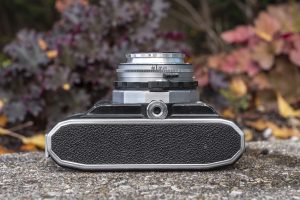
The bottom plate of the camera has nothing on it other than a large piece of body covering. A 1/4″ tripod socket is centrally located on a round platform beneath the shutter, and if you look closely, there is a black handle on the bottom of the shutter speed ring, which allows you to change shutter speeds with your finger while supporting the camera’s bottom.
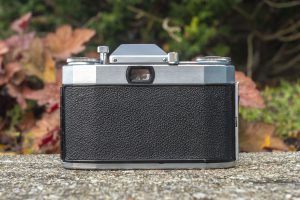
The back of the camera is plain with nothing to see other than the rectangular eyepiece for the viewfinder. This model is the Savoyflex II, but on the later 2E, a sliding switch to the left of the viewfinder was added for manually lifting the mirror when shooting the camera in Bulb mode. On this model, no special step is necessary when shooting long exposures.
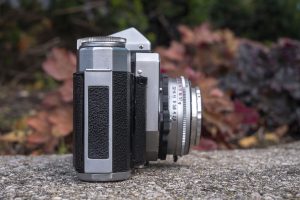
The sides of the camera are bare, without any flash connectors or strap lugs. Carrying the camera around your neck requires you to still have the original case or one of those tripod strap connectors. The right side has a sliding release for opening the film compartment, but otherwise there’s nothing to see.
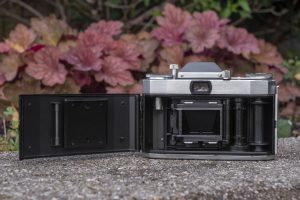
The film door is hinged on the left side, but film transport is from left to right onto a fixed and single slotted take up spool. The film pressure plate is painted black metal and there is a roller on the inside of the door to help aide film transport.
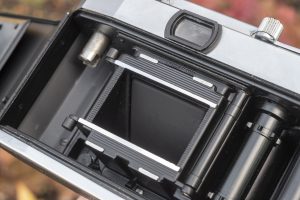
The most interesting thing inside the film compartment is the film gate which appears to hover over an empty void within the film compartment. In the image to the left, you can see a gap below the film gate and the bottom of the camera that is not typically seen on most 35mm cameras. Two small cylindrical posts to the left of the film gate help support film as it travels out of the film cassette and over the film gate. This arrangement is quite strange and not like anything I’ve ever seen in another camera. I am unsure if this was a cost cutting measure, or if there was a logic to it. In use, it works fine, it’s just different.
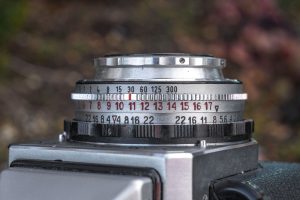
The Savoyflex uses a Prontor Reflex leaf shutter, and like most leaf shutters, all exposure controls are on rings around the lens. Looking down upon the top of the shutter, the black ring closest to the camera body is the focusing helix. The full motion of focus from 0.8m to infinity requires a rotation of around 100 degrees, which is very reasonable for a camera of this era.
Exposure is controlled via a single ring around the perimeter of the shutter. Like many cameras of the 1950s, the Savoyflex uses Light Value (LV) numbers from 2 – 17. This LV ring couples the shutter speed and aperture together so that any change to shutter speed, makes a corresponding change to the aperture to keep the LV number the same. The aperture ring has separate scales marked with f/stops and another with Light Value numbers. In the image to the right, the ring is set to LV 11, which has a shutter speed of 1/30 and f/8.
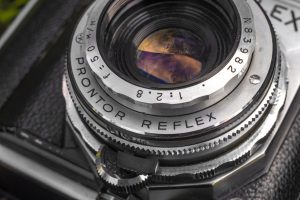
The only way to select a different LV or combination of shutter speed and aperture is to press in on a small black tab on the bottom of the shutter and rotate the ring while maintaining pressure on this tab. In practice, this is very inconvenient as the location of this tab gets in the way of the focusing tab of the lens. If you have the lens focused anywhere from about 5 meters to Infinity, the two tabs overlap, making changing LV numbers impossible. In the image to the left, the lens is focused to infinity where the focusing and exposure tabs are overlapping each other. In order to select a different combination of shutter speeds and aperture, the lens must be moved away from infinity focus, the exposure changed, and then the lens refocused back to infinity.
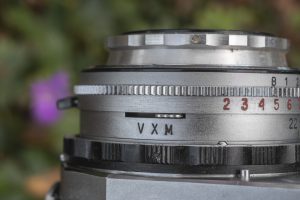
The Prontor Reflex shutter is flash synchronized for both M (at 1/30) and X (all speeds) bulbs. A third position marked “V” is a self-timer, allowing you to set the shutter with an 8-10 second delay before the shutter will fire. As is the case with most half century old leaf shutter cameras, you should avoid trying to use the self-timer as it can jam the shutter.
The viewfinder is large and reasonably bright, especially for a 1950s SLR, owing to the pronounced Fresnel rings on the focusing screen. In the center is a diagonal split image focusing aide and large ground glass circle, either of which can be used to focus the camera. Like most Fresnel pattern screens of the era, the area outside of the ground glass cannot accurately be used for determining focus. This was a compromise of many SLRs of the era like the Zeiss-Ikon Contaflex in which a tradeoff of a brighter screen was preferred over the ability to focus the camera using the entire focusing screen. This is neither good nor bad, as using both the split image and ground glass circles is good enough for most situations.
In the images below, the first shows the viewfinder with the lens focused to where the playhouse is in focus, and in the second showing it at minimum focus. Notice that although the area in the Fresnel pattern is not as sharp as the first image, it is less obvious than in the ground glass circle around the split image.
The third image, shows an issue with the rapid return mirror which darkens the viewfinder with any amount of pressure on the shutter release. I commented on this in my recent review of the Rectaflex which has the same problem in which the tiniest pressure on the shutter release starts to move the mirror, blocking light from entering the viewfinder. In the third image, I am barely pressing down on the shutter release. As you can see, the image starts to disappear almost immediately causing you to lose the ability to see your image. This, combined with the long travel of the shutter release increases the length of time in which you cannot see your composition. This is a huge deal when capturing things in motion, but even with still images, you have to be very careful to hold the camera steady while pressing down on the button or else you risk motion blur. Later Savoyflexes upgraded the rapid return mirror to an instant one, which would eliminate this problem, making them much easier to use.
Circling back to what I said earlier about seeing a Savoyflex in a YouTube video and lusting after one for quite some time, now that I had one in my hands and had the opportunity to see how it works, I must say, I was less than impressed. The Savoyflex was not produced for very long and after it’s discontinuation, I don’t think any other SLRs ever came out of France, so there has to be a reason, right?
Since a camera’s purpose is to make images, a poorly designed model can be redeemed by good images, so as I say in this part of every review I write, how does it shoot?
My Results
Whenever I select a roll of film to be used in a camera for the first time, I usually select something that I think works well with the time of year or location where I plan on shooting the camera.
In the case of the Savoyflex, although the camera appeared to be in perfect working condition, while testing it out, I could clearly see that body shake was going to be an issue as a result of the design of the rapid return mirror, so I wanted a faster film which would allow me to use the camera at it’s fastest 1/300 shutter speed. My selection of fast color films is very thin, so I chose a roll of Fuji 400 that I had in my film drawer and hoped for the best.
My choice of a 400 speed film on a camera with a top 1/300 shutter speed was a mixed bag as a majority of the images from this roll came out a tad underexposed. In every image above, I had to do some correction in Photoshop, but the results are reasonably decent to where I think a few conclusions can be made.
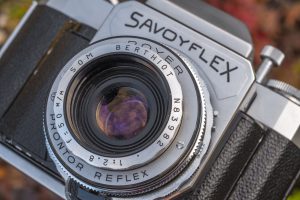
Starting with the good, the SOM Berthiot f/2.8 lens produced images with good center sharpness and only the slightest hint of softness at the corners. I was not able to find any info about the makeup of the lens’s design, but I can clearly count 4 reflections in the lens, so whether this is a Tessar copy or variant is anyone’s guess, but I feel confident in suggesting that this lens produced images on par with any other 1950s f/2.8 Tessar.
The bright viewfinder and combination of diagonal split image focus aide and large ground glass circle allowed me to accurately focus every image on the roll. The Fresnel pattern on the focusing screen maintained brightness into the corners, meaning the camera can easily be shot indoors, or in heavy shade. Lastly, wearing prescription glasses did not impede my ability to see all four edges of the screen.
I wish I could say the rest of the camera was as promising as it’s lens and viewfinder, but for the most part, everything else about the Savoyflex was a disaster. Starting with the ergonomics, the location of the left handed shutter release was a minor annoyance, but it was it’s excessively long throw that bothered me the most.
The Savoyflex has what’s called a Rapid Return Mirror. By the time this camera was first produced, most SLRs were starting to come with what was called an Instant Return Mirror. Although both designs couple the movement of the reflex mirror to the shutter release, how it’s done is different.
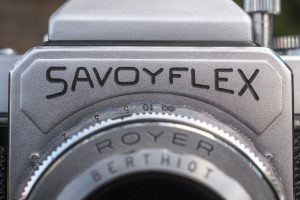
With an Instant Return Mirror, the mirror flips up out of the way only for the instant the shutter is open, and it instantly flips back down upon completion of the shutter cycle. A Rapid Return Mirror is directly controlled by pressure on the shutter release button. As your finger presses down on the shutter release, a cable raises the mirror. Release pressure on the shutter release and the mirror comes back down. The speed at which the mirror moves is proportionate to the amount of pressure you put on the shutter release. Press or release it slowly and the mirror moves slowly, press it harder, and the mirror moves with the same level of urgency.
The length of time the viewfinder becomes blacked out begins the moment you start to apply pressure on the shutter release, and only becomes usable again when all pressure is released from the shutter release, greatly increasing the amount of time the viewfinder is blacked out. I am used to giving slow and steady pressure on a camera’s shutter release so as not to induce body shake, but when doing this on the Savoyflex, the long throw of the shutter release meant that the length of time where I couldn’t see through the viewfinder was significant.
Beyond the viewfinder, the Savoyflex has one of the worst implementations of a Light Value Scale on any camera I’ve used. Most of the time, shutter speeds and apertures are still controlled by two rings, and the LV coupling can be overridden by continuing to turn each ring beyond the limit of the coupling. Not with the Savoyflex.
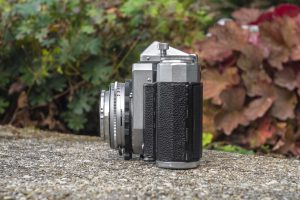
In order to override the coupling, you must press in on a black tab at the base of the shutter, but the location of this tab overlaps the focus control tab when the lens is focused anywhere from 5 meters to Infinity. This means if you are out shooting landscapes with the focus set to infinity and your light changes requiring you to adjust exposure, you must first move the focus tab out of the way, then press in the tab to change LV numbers, and then refocus the lens back to infinity.
This arrangement of controls is idiotic. Not to mention, cameras with Light Value Scales existed for at least three years before the first Savoyflex was introduced, giving the company plenty of time to see how it should be implemented.
There were a few other nitpicks that on a better camera, wouldn’t have lessened the shooting experience, but on a camera I already wasn’t liking, the lack of any sort of strap lugs requiring you to keep the original case was a poor choice, as was the left hinged film door with left to right film transport. Normally, left to right film compartments are hinged on the right, meaning that any kind of light leak that could come through the latch is on the same side as already exposed film, increasing your chances of light leaks.
Most of the time, if I get lackluster results from a camera on it’s first roll, I’ll gladly shoot a second in the hope that I learned enough to improve upon it, but not this time. Quite simply, I hated shooting the Savoyflex. I loaded in a 24 exposure roll, and I was barely a third of the way through that roll before I was looking forward to finishing it. I won’t blame the camera for my selection of film, and the SOM Berthiot’s lens did reasonably well, but overall, this is a camera I will never come back to again.
Related Posts You Might Enjoy
External Links
http://glangl1.free.fr/Photo2/Photo_S_1019.html
http://www.pentax-slr.com/108413524
https://www.collection-appareils.fr/x/html/appareil-1211.html

